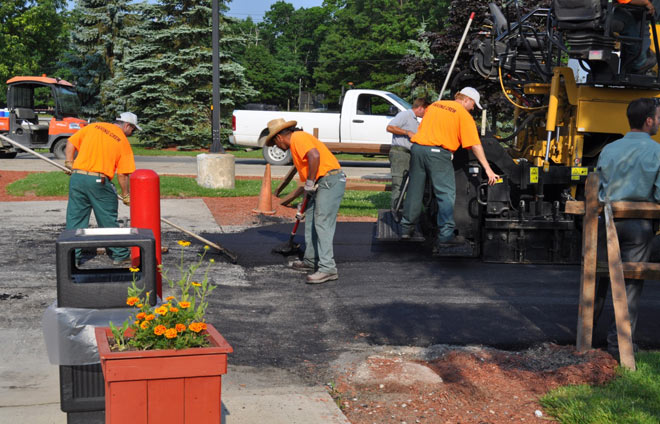Having non-violent drug offenders like Jonathan Andrade (pictured above with his fiancée Theresa) build President Trump's proposed border wall is not a new idea, but it seems to get dismissed out-of-hand without anyone seriously analyzing the viability of the prospect.
Mr. Andrade, who refused to turn others in and who is facing 20 to 22 years under antiquated minimum mandatory sentencing laws since his sentencing hearing in federal court in Boston in June, hopes that will change. The physically-fit 36-year-old whose been a unit worker at the Plymouth County Correctional Facility (PCCF) says that he would gladly sign up to work outside, gain experience in the construction industry and work on a civil engineering project of national importance – especially if the Trump administration would use its' sole Constitutional authority to take some time off of the 2-decade prison term so that he could get back home and marry Theresa a little earlier.
And he's certainly not the only one who'd volunteer.
Further, having federal as opposed to state inmates work on this huge project, at least at first, would ease a whole host of practical and logistical challenges. For starters, the agency which oversees federal prisoners, the Federal Bureau of Prisons (BOP), is part of the executive branch headed by the Commander-in-Chief, and the president also has the unilateral ability to reduce federal sentences by granting clemency, which is different than his power to grant full pardons. So President Trump can already do a great deal of what would be required with the powers vested in his office.
Towards that end, a WhiteHouse.gov petition calling on the Trump administration to offer a work-for-clemency program to build the wall and other projects is accepting signatures here.
Additionally, there are no jurisdictional concerns regarding state borders when it comes to federal prisoners, who are already routinely bussed and flown around the country in large numbers every day. Indeed, the scale of the massive federal prison system, which currently holds about 200,000 people, meets the scale of the proposed wall and using its existing transportation and supply infrastructure, hundreds if not thousands of inmates and tons of food, water and other supplies could arrive at work sites on a daily basis.

Federal prisoners depart air transport. (USMarshals.gov) According to the unofficial "federal prison handbook" by Christopher Zoukis, "With more than 200 institutions, the [Federal] Bureau [of Prisons] processes hundreds of thousands of inmate movements every year."
In fact, the project could actually help the Federal Bureau of Prisons (BOP) in one of the areas where it currently draws some of its sharpest criticism from the left when compared to its state-level counterparts: Federal inmates like Mr. Andrade face a comparable lack of job-training programs to prepare them to support themselves and their families without breaking the law again when they get out and there's almost nothing that federal prisoners like him can do while incarcerated to actively reduce the length of their sentences through so-called “earned good time.” This outmoded philosophy, especially when compared to those of more up-to-date state prison systems, has helped to earn the Federal BOP the moniker, “backwards on purpose.”
And Mr. Andrade, who has been with Theresa for 7 years, is already planning to pursue the only option that is currently available for federal inmates like him to earn time off of their sentences, the BOP's Residential Drug Abuse Program or RDAP (commonly pronounced “are-dapp”). After not 1 single arrest for any violent crime in his entire life, but many past arrests for small amounts of drugs which are now being used to strong arm Mr. Andrade into a guilty plea lest he face a mandatory life sentence under federal 3 strikes laws, RDAP will be the first time that he has been offered any meaningful substance abuse therapy for a problem that has led to him being pistol whipped while his home was invaded. He would welcome any additional pathway that would allow him to get back to his fiancée earlier.

Jonathan Andrade and his fiancée Theresa on a balcony, date unknown. Unless something changes, the two will not be able to wed until 2032. (Photo courtesy of Theresa)
Otherwise, with only RDAP and the roughly 15% time off for good behavior which all federal inmates are supposed to receive by law as long as they maintain a good record behind bars, the two will have to wait until at least 2032 – the absolute soonest he could hope to qualify for a federal halfway-house under the status quo.
Further, RDAP only takes time off of sentences for non-violent offenders whose crimes were alcohol or drug related, like Mr. Andrade, who already served 2 years in the same county jail for previous marijuana charges that wouldn’t be considered criminal offenses under the modern laws in his state. But, for thousands of others, only a new program which, for example, potentially offers clemency in exchange for helping to build the border wall, would have the ability to get them out any earlier.
So, with President Trump having noted in his State of the Union address that his administration wants to ensure that prisoners are given a fair second chance to rebuild their lives after they’re done serving their time and with Democrats historically having placed a high value on rehabilitation in their rhetoric as well, Mr. Andrade, his fiancée Theresa and many others with whom I've spoken are hoping that both sides of the political aisle can make something happen, or that at least Congress won't block the President from implementing something largely on his own. After all, some who view the wall as unnecessary may find it useful in this proposed capacity to provide job training, reduce recidivism as well as reduce prison over-crowding and mass-incarceration while also perhaps even providing a sense of purpose for federal inmates and possibly eventually state prisoners as well. Further, other large-scale learn-on-the-job construction projects could follow the wall.
The Democrats could also celebrate the union jobs that would be saved or created to produce the necessary building equipment and supplies, which would make up the lion's share of any money that Congress would have to appropriate for such endeavors. At the same time, the left would be contributing to a path out from underneath the mandatory minimum sentencing laws that it has been railing against for years and which have thousands like Mr. Andrade at their mercy.
But of course, for Mr. Andrade, his fiancée and the others which whom I've spoken, this isn't political, it's about their lives.
Moreover, they know that there are significant obstacles in the way, including those of public perception. For example, few are aware that many federal inmates are already using heavy equipment for a variety of jobs, apparently with no more issues than their incarcerated counterparts.

Federal Bureau of Prisons (BOP) inmates already work outside with heavy equipment – and without fences. (BOP.gov)
And not every federal prisoner would eligible to help with the wall. Few may have heard of it, but the BOP already has a classification system and federal inmates are housed in a spectrum of facilities ranging from the administrative maximum security prison in Colorado to minimum security camps, the vast majority of which do not have fences. Yet escape attempts from such minimum security federal institutions are nearly non-existent.
Further, not every prisoner helping with the wall would have to be physically on the border since there would be plenty of positions in the supporting infrastructure and in the supply chain. One could also imagine roles for physically disabled inmates who want to help and earn time off.
Certainly, my experience across 6 detention facilities in the past 27 months indicates that there would be no shortage of prisoners who would volunteer in exchange for clemency and I can't think of a single inmate who would make a break for it in to miles of arid Mexican desert, especially if they knew that their sentence was going to be reduced. Further, other incentives which are commonly employed in state prisons but which have been previously unavailable to federal inmates could attract even more participants while reducing potential problems.
If you would like to see a work-for-clemency program to build the border wall and other projects, you can sign a WhiteHouse.gov petition here. Mr. Andrade, his fiancée Theresa and many others are hoping that Americans will sign and share the petition for various reasons, including the desire to see the wall get built, the desires of friends and families of other prisoners nationwide to help their loved ones earn their way home sooner, as well as the desire of others to better prepare inmates to live productive, law-abiding lives on the outside when they rejoin society.
You can help the author through his unjust incarceration at the hands of crooked federal prosecutors by visiting FreeMartyG.com and donating or following the FreeMartyG social media pages.

 Donate Now
Donate Now
 Follow
Follow 
